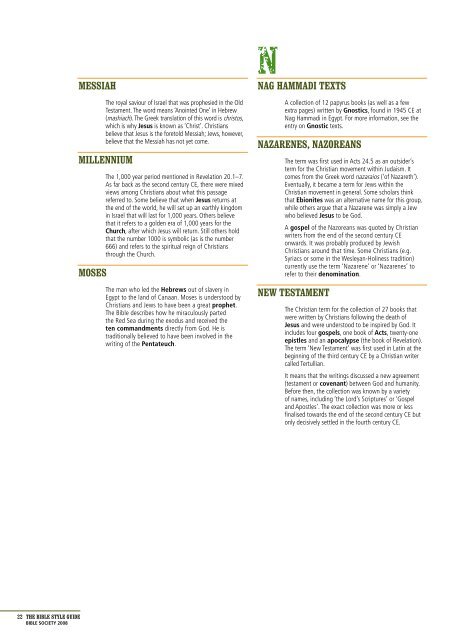BiBle STyle Guide - Get a Free Blog
BiBle STyle Guide - Get a Free Blog
BiBle STyle Guide - Get a Free Blog
You also want an ePaper? Increase the reach of your titles
YUMPU automatically turns print PDFs into web optimized ePapers that Google loves.
22 The <strong>BiBle</strong> <strong>STyle</strong> <strong>Guide</strong><br />
bible society 2008<br />
messiah<br />
The royal saviour of Israel that was prophesied in the Old<br />
Testament. The word means ‘Anointed One’ in Hebrew<br />
(mashiach). The Greek translation of this word is christos,<br />
which is why Jesus is known as ‘Christ’. Christians<br />
believe that Jesus is the foretold Messiah; Jews, however,<br />
believe that the Messiah has not yet come.<br />
millenniUm<br />
moses<br />
The 1,000 year period mentioned in Revelation 20.1–7.<br />
As far back as the second century CE, there were mixed<br />
views among Christians about what this passage<br />
referred to. Some believe that when Jesus returns at<br />
the end of the world, he will set up an earthly kingdom<br />
in Israel that will last for 1,000 years. Others believe<br />
that it refers to a golden era of 1,000 years for the<br />
church, after which Jesus will return. Still others hold<br />
that the number 1000 is symbolic (as is the number<br />
666) and refers to the spiritual reign of Christians<br />
through the Church.<br />
The man who led the Hebrews out of slavery in<br />
Egypt to the land of Canaan. Moses is understood by<br />
Christians and Jews to have been a great prophet.<br />
The Bible describes how he miraculously parted<br />
the Red Sea during the exodus and received the<br />
ten commandments directly from God. He is<br />
traditionally believed to have been involved in the<br />
writing of the Pentateuch.<br />
n<br />
nag hammadi texts<br />
A collection of 12 papyrus books (as well as a few<br />
extra pages) written by Gnostics, found in 1945 CE at<br />
Nag Hammadi in Egypt. For more information, see the<br />
entry on Gnostic texts.<br />
nazarenes, nazoreans<br />
The term was first used in Acts 24.5 as an outsider’s<br />
term for the Christian movement within Judaism. It<br />
comes from the Greek word nazaraios (‘of Nazareth’).<br />
Eventually, it became a term for Jews within the<br />
Christian movement in general. Some scholars think<br />
that ebionites was an alternative name for this group,<br />
while others argue that a Nazarene was simply a Jew<br />
who believed Jesus to be God.<br />
A gospel of the Nazoreans was quoted by Christian<br />
writers from the end of the second century CE<br />
onwards. It was probably produced by Jewish<br />
Christians around that time. Some Christians (e.g.<br />
Syriacs or some in the Wesleyan-Holiness tradition)<br />
currently use the term ‘Nazarene’ or ‘Nazarenes’ to<br />
refer to their denomination.<br />
new testament<br />
The Christian term for the collection of 27 books that<br />
were written by Christians following the death of<br />
Jesus and were understood to be inspired by God. It<br />
includes four gospels, one book of Acts, twenty-one<br />
epistles and an apocalypse (the book of Revelation).<br />
The term ‘New Testament’ was first used in Latin at the<br />
beginning of the third century CE by a Christian writer<br />
called Tertullian.<br />
It means that the writings discussed a new agreement<br />
(testament or covenant) between God and humanity.<br />
Before then, the collection was known by a variety<br />
of names, including ‘the Lord’s Scriptures’ or ‘Gospel<br />
and Apostles’. The exact collection was more or less<br />
finalised towards the end of the second century CE but<br />
only decisively settled in the fourth century CE.


